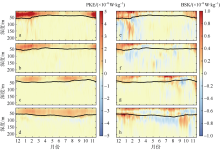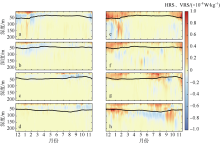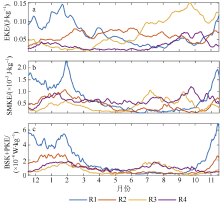Journal of Tropical Oceanography ›› 2021, Vol. 40 ›› Issue (5): 10-24.doi: 10.11978/2020116CSTR: 32234.14.2020116
• Marine Physics • Previous Articles Next Articles
Spatial and seasonal differences of the upper-ocean submesoscale processes in the South China Sea
YANG Xiaoxiao1( ), CAO Haijin1(
), CAO Haijin1( ), JING Zhiyou2
), JING Zhiyou2
- 1. College of Oceanography, Hohai University, Nanjing 210024, China
2. State Key Laboratory of Tropical Oceanography (South China Sea Institute of Oceanology, Chinese Academy of Sciences), Guangzhou 510301, China
-
Received:2020-09-30Revised:2021-03-05Online:2021-09-10Published:2021-03-15 -
Contact:CAO Haijin E-mail:181311010026@hhu.edu.cn;h.cao@hhu.edu.cn -
Supported by:National Key Research and Development Program of China(2017YFA0604104);Opening Foundation of State Key Laboratory of Tropical Oceanography(South China Sea Institute of Oceanology)(LTO1907);Chinese Postdoctoral Foundation(2018M642148);Jiangsu Planned Projects for Postdoctoral Research Funds(2018K149C);National Natural Science Foundation of China(41776040);Laboratory for Ocean Dynamics and Climate, Pilot Qingdao National Laboratory for Marine Science and Technology(OCFL-201804)
CLC Number:
- P731.27
Cite this article
YANG Xiaoxiao, CAO Haijin, JING Zhiyou. Spatial and seasonal differences of the upper-ocean submesoscale processes in the South China Sea[J].Journal of Tropical Oceanography, 2021, 40(5): 10-24.
share this article
Add to citation manager EndNote|Reference Manager|ProCite|BibTeX|RefWorks
Tab. 1
Seasonal averages of characteristic parameters of different regions in the upper 50 m"
| 次中尺度特征参量 | 区域 | 冬季(12—2月) | 春季(3—5月) | 夏季(6—8月) | 秋季(9—11月) |
|---|---|---|---|---|---|
| ζ/f的均方根值在不同 季节内的平均值 | R1 | 0.51 | 0.32 | 0.21 | 0.32 |
| R2 | 0.41 | 0.37 | 0.30 | 0.30 | |
| R3 | 0.38 | 0.33 | 0.47 | 0.51 | |
| R4 | 0.70 | 0.73 | 0.70 | 0.72 | |
| δ/f的均方根值在不同 季节内的平均值 | R1 | 0.19 | 0.11 | 0.07 | 0.12 |
| R2 | 0.13 | 0.08 | 0.07 | 0.07 | |
| R3 | 0.15 | 0.09 | 0.18 | 0.14 | |
| R4 | 0.31 | 0.26 | 0.26 | 0.24 | |
| S/f在不同季节内的 平均值 | R1 | 0.42 | 0.27 | 0.19 | 0.27 |
| R2 | 0.34 | 0.32 | 0.25 | 0.25 | |
| R3 | 0.32 | 0.29 | 0.37 | 0.38 | |
| R4 | 0.58 | 0.58 | 0.57 | 0.55 |
| [1] | 黄小龙, 经志友, 郑瑞玺, 等, 2020. 南海西部夏季上升流锋面的次中尺度特征分析[J]. 热带海洋学报, 39(3):1-9. |
| HUANG XIAOLONG, JING ZHIYOU, ZHENG RUIXI, et al, 2020. Analysis of submesoscale characteristics of summer upwelling fronts in the western South China Sea[J]. Journal of Tropical Oceanography, 39(3):1-9 (in Chinese with English abstract). | |
| [2] | 罗士浩, 经志友, 齐义泉, 等, 2016. 南海北部次中尺度过程数值研究[J]. 热带海洋学报, 35(5):10-19. |
| LUO SHIHAO, JING ZHIYOU, QI YIQUAN, et al, 2016. Numerical study on sub-mesoscale processes in the northern South China Sea[J]. Journal of Tropical Oceanography, 35(5):10-19 (in Chinese with English abstract). | |
| [3] | 赵伟, 侯一筠, 乐肯堂, 等, 2007. 吕宋海峡水交换季节变化的数值研究[J]. 海洋与湖沼, 38(6):495-503. |
| ZHAO WEI, HOU YIJUN, LE KENTANG, et al, 2007. Numerical study on seasonal variation of water exchange in the Luzon strait[J]. Oceanologia et Limnologia Sinica, 38(6):495-503 (in Chinese with English abstract). | |
| [4] | 郑瑞玺, 经志友, 罗世浩, 2018. 南海北部反气旋涡旋边缘的次中尺度动力过程分析[J]. 热带海洋学报, 37(3):19-25. |
| ZHENG RUIXI, JING ZHIYOU, LUO SHIHAO, 2018. Analysis of sub-mesoscale dynamic processes in the periphery of anticyclonic eddy in the northern South China Sea[J]. Journal of Tropical Oceanography, 37(3):19-25 (in Chinese with English abstract). | |
| [5] |
BOCCALETTI G, FERRARI R, FOX-KEMPER B, 2007. Mixed layer instabilities and restratification[J]. Journal of Physical Oceanography, 37(9):2228-2250.
doi: 10.1175/JPO3101.1 |
| [6] |
BÜHLER O, CALLIES J, FERRARI R, 2014. Wave-vortex decomposition of one-dimensional ship-track data[J]. Journal of Fluid Mechanics, 756:1007-1026.
doi: 10.1017/jfm.2014.488 |
| [7] |
CAO HAIJIN, JING ZHIYOU, FOX-KEMPER B, et al, 2019. Scale transition from geostrophic motions to internal waves in the northern South China Sea[J]. Journal of Geophysical Research: Oceans, 124(12):9364-9383.
doi: 10.1029/2019JC015575 |
| [8] | CAO HAIJIN, FOX-KEMPER B, JING ZHIYOU, 2021. Submesoscale eddies in the upper ocean of the Kuroshio Extension from high-resolution simulation: energy budget[J]. Journal of Physical Oceanography, 51(7):2181-2201. |
| [9] |
CAPET X, MCWILLIAMS J C, MOLEMAKER M J, et al, 2008. Mesoscale to submesoscale transition in the California current system. Part Ⅲ: Energy balance and flux[J]. Journal of Physical Oceanography, 38(10):2256-2269.
doi: 10.1175/2008JPO3810.1 |
| [10] | CHELTON D B, SCHLAX M G, SAMELSON R M, et al, 2007. Global observations of large oceanic eddies[J]. Geophysical Research Letters, 34(15):L15606. |
| [11] |
DAUHAJRE D P, MCWILLIAMS J C, UCHIYAMA Y, 2017. Submesoscale coherent structures on the continental shelf[J]. Journal of Physical Oceanography, 47(12):2949-4976.
doi: 10.1175/JPO-D-16-0270.1 |
| [12] |
DONG CHANGMING, MCWILLIAMS J C, SHCHEPETKIN A F, et al, 2007. Island wakes in deep water[J]. Journal of Physical Oceanography, 37(4):962-981.
doi: 10.1175/JPO3047.1 |
| [13] | DONG JIHAI, ZHONG YISEN, 2018. The spatiotemporal features of submesoscale processes in the northeastern South China Sea[J]. Acta Oceanologica Sinica, 37(11):8-18. |
| [14] |
FERRARI R, WUNSCH C, 2009. Ocean circulation kinetic energy: Reservoirs, sources, and sinks[J]. Annual Review of Fluid Mechanics, 41:253-282.
doi: 10.1146/annurev.fluid.40.111406.102139 |
| [15] |
HAINE T W N, MARSHALL J, 1998. Gravitational, symmetric, and baroclinic instability of the ocean mixed layer[J]. Journal of Physical Oceanography, 28(4):634-658.
doi: 10.1175/1520-0485(1998)028<0634:GSABIO>2.0.CO;2 |
| [16] |
HOSKINS B J, 1974. The role of potential vorticity in symmetric stability and instability[J]. Quarterly Journal of the Royal Meteorological Society, 100(425):480-482.
doi: 10.1002/(ISSN)1477-870X |
| [17] |
LAPEYRE G, KLEIN P, HUA B L, 2006. Oceanic restratification forced by surface frontogenesis[J]. Journal of Physical Oceanography, 36(8):1577-1590.
doi: 10.1175/JPO2923.1 |
| [18] |
LI JIANING, DONG JIHAI, YANG QINGXUAN, et al, 2019. Spatial-temporal variability of submesoscale currents in the South China Sea[J]. Journal of Oceanology and Limnology, 37(2):474-485.
doi: 10.1007/s00343-019-8077-1 |
| [19] |
LIN HONGYANG, LIU ZHIYU, HU JIANYU, et al, 2020. Characterizing meso- to submesoscale features in the South China Sea[J]. Progress in Oceanography, 188:102420.
doi: 10.1016/j.pocean.2020.102420 |
| [20] |
LIU GUOQIANG, HE YIJUN, SHEN HUI, et al, 2010. Submesoscale activity over the shelf of the northern South China Sea in summer: simulation with an embedded model[J]. Chinese Journal of Oceanology and Limnology, 28(5):1073-1079.
doi: 10.1007/s00343-010-0030-2 |
| [21] |
MAHADEVAN A, TANDON A, 2006. An analysis of mechanisms for submesoscale vertical motion at ocean fronts[J]. Ocean Modelling, 14(3-4):241-256.
doi: 10.1016/j.ocemod.2006.05.006 |
| [22] | MCWILLIAMS J C, MOLEMAKER M J, YAVNEH I, 2001. From stirring to mixing of momentum: Cascades from balanced flows to dissipation in the oceanic interior[R]. Los Angeles, CA: Institute of Geophysics and Planetary Physics, University of California. |
| [23] |
MOLEMAKER M J, MCWILLIAMS J C, YAVNEH I, 2005. Baroclinic instability and loss of balance[J]. Journal of Physical Oceanography, 35(9):1505-1517.
doi: 10.1175/JPO2770.1 |
| [24] |
QIU BO, CHEN SHUIMING, KLEIN P, et al, 2014. Seasonal mesoscale and submesoscale eddy variability along the North Pacific subtropical countercurrent[J]. Journal of Physical Oceanography, 44(12):3079-3098.
doi: 10.1175/JPO-D-14-0071.1 |
| [25] | RUDNICK D L, LUYTEN J R, 1996. Intensive surveys of the Azores Front: 1. Tracers and dynamics[J]. Journal of Geophysical Research: Oceans, 101(C1):923-939. |
| [26] | SPALL S A, RICHARDS K J, 2000. A numerical model of mesoscale frontal instabilities and plankton dynamics —Ⅰ. Model formulation and initial experiments[J]. Deep Sea Research Part Ⅰ: Oceanographic Research Papers, 47(7):1261-1301. |
| [27] |
STAMMER D, 1997. Global characteristics of ocean variability estimated from regional TOPEX/POSEIDON altimeter measurements[J]. Journal of Physical Oceanography, 27(8):1743-1769.
doi: 10.1175/1520-0485(1997)027<1743:GCOOVE>2.0.CO;2 |
| [28] |
TANDON A, GARRETT C, 1995. Geostrophic adjustment and restratification of a mixed layer with horizontal gradients above a stratified layer[J]. Journal of Physical Oceanography, 25(10):2229-2241.
doi: 10.1175/1520-0485(1995)025<2229:GAAROA>2.0.CO;2 |
| [29] | THOMAS L N, TANDON A, MAHADEVAN A, 2008. Submesoscale processes and dynamics[M]// HECHT M W, HASUMI H. Ocean modeling in an Eddying Regime. American Geophysical Union, 177:17-38. |
| [30] | THOMAS L N, TAYLOR J R, FERRARI R, et al, 2013. Symmetric instability in the Gulf Stream[J]. Deep Sea Research Part Ⅱ: Topical Studies in Oceanography, 91:96-110. |
| [31] |
TORRES H S, KLEIN P, MENEMENLIS D, et al, 2018. Partitioning ocean motions into balanced motions and internal gravity waves: A modeling study in anticipation of future space missions[J]. Journal of Geophysical Research: Oceans, 123(11):8084-8105.
doi: 10.1029/2018JC014438 |
| [32] |
YANG QINGXUAN, ZHAO WEI, LIANG XINFENG, et al, 2017. Elevated mixing in the periphery of mesoscale eddies in the South China Sea[J]. Journal of Physical Oceanography, 47(4):895-907.
doi: 10.1175/JPO-D-16-0256.1 |
| [33] |
YU JIE, ZHENG QUANAN, JING ZHIYOU, et al, 2018. Satellite observations of sub-mesoscale vortex trains in the western boundary of the South China Sea[J]. Journal of Marine Systems, 183:56-62.
doi: 10.1016/j.jmarsys.2018.03.010 |
| [34] |
ZENG XUEZHI, BELKIN I M, PENG SHIQIU, et al, 2014. East Hainan upwelling fronts detected by remote sensing and modelled in summer[J]. International Journal of Remote Sensing, 35(11-12):4441-4451.
doi: 10.1080/01431161.2014.916443 |
| [35] |
ZHANG ZHIWEI, TIAN JIWEI, QIU BO, et al, 2016. Observed 3D structure, generation, and dissipation of oceanic mesoscale eddies in the South China Sea[J]. Scientific Reports, 6:24349.
doi: 10.1038/srep24349 |
| [36] | ZHANG ZHIWEI, ZHANG YUCHEN, QIU BO, et al, 2020. Spatiotemporal characteristics and generation mechanisms of submesoscale currents in the northeastern South China Sea revealed by numerical simulations[J]. Journal of Geophysical Research: Oceans, 125(2): e2019JC015404. |
| [37] | ZHENG QUANAN, 2017. Satellite SAR detection of sub-mesoscale ocean dynamic processes[M]. London: World Scientific: 121-178. |
| [38] | ZHENG wQUANAN, XIE LINGLING, XIONG XUEJUN, et al, 2020. Progress in research of submesoscale processes in the South China Sea[J]. Acta Oceanologica Sinica, 39(1):1-13. |
| [39] |
ZHONG YISEN, BRACCO A, TIAN JIWEI, et al, 2017. Observed and simulated submesoscale vertical pump of an anticyclonic eddy in the South China Sea[J]. Scientific Reports, 7(1):44011.
doi: 10.1038/srep44011 |
| [1] | XU Chao, LONG Lijuan, LI Sha, YUAN Li, XU Xiaolu. Systematic reorganization of historical data of scientific investigation in the South China Sea and its affiliated islands and reefs 3. data sharing service and application [J]. Journal of Tropical Oceanography, 2024, 43(5): 158-165. |
| [2] | XU Chao, LONG Lijuan, LI Sha, HE Yunkai, YUAN Li, XU Xiaolu. Systematic reorganization of historical data of scientific investigation in the South China Sea and its affiliated islands and reefs 1. data reorganization technology and application [J]. Journal of Tropical Oceanography, 2024, 43(5): 143-149. |
| [3] | XU Chao, LONG Lijuan, LI Sha, XU Xiaolu, YUAN Li. Systematic reorganization of historical data of scientific investigation in the South China Sea and its affiliated islands and reefs 2. data curation and application [J]. Journal of Tropical Oceanography, 2024, 43(5): 150-157. |
| [4] | SUN Zeming, HAN Shuzong, WANG Mingjie, SU Hanxiang. Statistical study on the influence of typhoon with different path on the temperature of coastal waters of China [J]. Journal of Tropical Oceanography, 2024, 43(5): 17-31. |
| [5] | LIU Yuan, KE Zhixin, LI Kaizhi, TAN Yehui, LIANG Junce, ZHOU Weihua. Zooplankton community in the coastal waters of eastern Guangdong under the influence of human activities and ocean currents [J]. Journal of Tropical Oceanography, 2024, 43(4): 98-111. |
| [6] | LIU Didi, ZHANG Xiyang, SUN Fulin, WANG Mingzhuang, TAN Fei, SHI Qi, WANG Guan, YANG Hongqiang. Microbial communities and specific strains within beachrocks of the South China Sea: implications for the origin of beachrock* [J]. Journal of Tropical Oceanography, 2024, 43(4): 112-122. |
| [7] | JIANG Lyumiao, CHEN Tianran, ZHAO Kuan, ZHANG Ting, XU Lijia. Experimental study on bioerosion of marginal reefs in the Weizhou Island, northern South China Sea [J]. Journal of Tropical Oceanography, 2024, 43(3): 155-165. |
| [8] | XU Lijia, LIAO Zhiheng, CHEN Hui, WANG Yongzhi, HUANG Baiqiang, LIN Qiaoyun, GAN Jianfeng, YANG Jing. Community structure of scleractinian corals in the northern South China Sea and their responses to the marine heatwaves [J]. Journal of Tropical Oceanography, 2024, 43(3): 58-71. |
| [9] | ZHAO Minghui, YUAN Ye, ZHANG Jiazheng, ZHANG Cuimei, GAO Jinwei, WANG Qiang, SUN Zhen, CHENG Jinhui. New developments on the rift-breakup of the continent-ocean transition zone in the northern margin of the South China Sea [J]. Journal of Tropical Oceanography, 2024, 43(2): 173-183. |
| [10] | HUANG Yu, WANG Lin, MAI Zhimao, LI Jie, ZHANG Si. Isolation and characterization of sand fixation ability of bacteria in biological soil crusts of the tropical islands, South China Sea [J]. Journal of Tropical Oceanography, 2023, 42(6): 101-110. |
| [11] | WANG Chenyan, SHI Jingwen, YAN Annan, KANG Yaru, WANG Yuxuan, QIN Suli, HAN Minwei, ZHANG Ruijie, YU Kefu. Bioaccumulation characteristics and source apportionment of organophosphate esters in Acanthaster planci from the South China Sea [J]. Journal of Tropical Oceanography, 2023, 42(5): 30-37. |
| [12] | LI Niu, DI Pengfei, FENG Dong, CHEN Duofu. The impact of cold seepage on geochemical indices for redox conditions of marine sediments ―Site F active seep site in the northeastern South China Sea* [J]. Journal of Tropical Oceanography, 2023, 42(5): 144-153. |
| [13] | ZHANG Zhisheng, XIE Lingling, LI Junyi, LI Qiang. Comparative analysis of mesoscale eddy evolution during life cycle in marginal sea and open ocean: South China Sea and Kuroshio Extension [J]. Journal of Tropical Oceanography, 2023, 42(4): 63-76. |
| [14] | YANG Lei, WEN Jinhui, WANG Qiang, LUO Xi, HUANG Huaming, HE Yunkai, CHEN Ju. Recent research progress in the influence of tropical cyclones on the Luzon Strait transport* [J]. Journal of Tropical Oceanography, 2023, 42(3): 40-51. |
| [15] | ZHAO Zhongxian, SUN Zhen, MAO Yunhua, ZHANG Huodai. Heterogeneous extension and pulsed tectonic subsidence in the northern South China Sea margin* [J]. Journal of Tropical Oceanography, 2023, 42(3): 96-115. |
|
||























